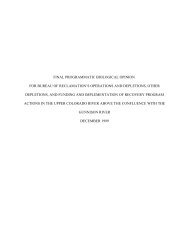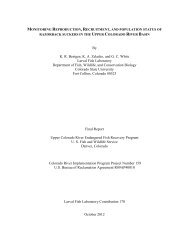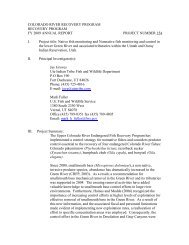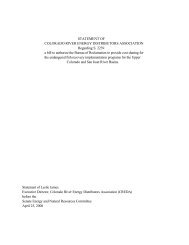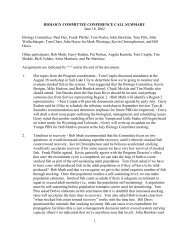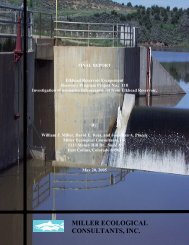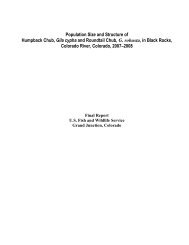riprap - Upper Colorado River Endangered Fish Recovery Program
riprap - Upper Colorado River Endangered Fish Recovery Program
riprap - Upper Colorado River Endangered Fish Recovery Program
You also want an ePaper? Increase the reach of your titles
YUMPU automatically turns print PDFs into web optimized ePapers that Google loves.
and timing of refinement of the recommendations. Instream-flow filings are on holdpending reevaluation of how flows will be legally protected in <strong>Colorado</strong>.In 2011, researchers reported increasing abundance of smallmouth bass (and evidenceof reproduction); <strong>Program</strong> will begin removing smallmouth bass from the White <strong>River</strong> in2012.3.5 COLORADO RIVER3.5.1 ImportanceThe mainstem <strong>Colorado</strong> <strong>River</strong> from Rifle, <strong>Colorado</strong>, to Lake Powell, Utah, supportspopulations of humpback chub and <strong>Colorado</strong> pikeminnow, and is recognized asimportant to the recovery of all four endangered fishes (U.S. <strong>Fish</strong> and Wildlife Service1990a, 1990b, 1991, 1998, 2002a, 2002b, 2002c, 2002d). Relatively large populationsof humpback chub occur at Black Rocks and Westwater canyons near the Utah-<strong>Colorado</strong> state line. However, both populations appear to have experienced a declinearound the year 2000 and have remained low since that time (Elverud in prep. andFrancis and McAda 2011). Population estimates begin again in 2011 and the <strong>Program</strong>will consider preliminary results and recommendations from reports currently inpreparation in deciding what steps need to be taken. A smaller humpback chubpopulation occurs in Cataract Canyon, and some of the last wild bonytail were collectedin this river reach. All life stages of <strong>Colorado</strong> pikeminnow occur in the section of riverfrom Palisade, <strong>Colorado</strong>, downstream to Lake Powell. Numbers of adult <strong>Colorado</strong>pikeminnow have continued to increase since 1992 (Osmundson and White 2009).<strong>Colorado</strong> pikeminnow have been translocated and stocked into the upper reach of the<strong>Colorado</strong> <strong>River</strong> between Palisade and Rifle, <strong>Colorado</strong>; natural access to this historichabitatreach until recently had been blocked since the early 1900's by three diversiondams near Palisade. Wild razorback sucker populations in the mainstem <strong>Colorado</strong><strong>River</strong> have declined precipitously in the past 20 years. Recapture of stocked razorbacksucker have increased in recent years.3.5.2 <strong>Recovery</strong> ActionsA variety of recovery actions are planned, ongoing, or completed for the <strong>Colorado</strong><strong>River</strong>. Numerous approaches are being taken to restore flows in the 15-mile reachimmediately upstream from the confluence of the Gunnison <strong>River</strong> to levelsrecommended by the Service. Reclamation has made available 5,000 acre-feet ofwater annually plus an additional 5,000 acre-feet in four of every five years from RuediReservoir to augment flows in the 15-mile reach during July, August, and September.In addition, water is available from the lease of 10,825 acre-feet/year of water fromRuedi Reservoir and permanent commitment of 10,825 acre-feet/year from East andWest slope water users. East and West slope 10-year commitments were secured in2000 by Memoranda of Agreement (MOA) with the <strong>Colorado</strong> <strong>River</strong> Water ConservationDistrict (CRWCD) and Denver Water for delivery of 5,412 acre-feet of water from21



